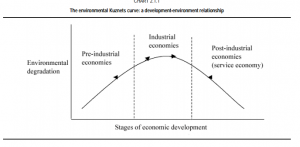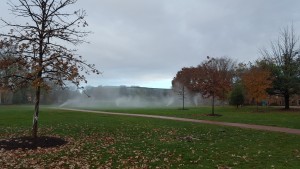Our adventure through Hawk Mountain and Cabela’s was, at times, inspiring, and others, disturbing. Both places aimed to appeal to broader audiences and consumers than just die-hard birders or lifelong deer hunters. They employed crafty marketing techniques to attract children, suburbanites, and those who may not otherwise be interested in nature. The main difference between these destinations, however, is that Hawk Mountain promotes and acts upon much more socially and environmentally beneficial goals while Cabela’s reeks of unnecessary consumerism, braggery, and violence.
Strolling through the small, yet well stocked, gift shop at the welcome center of Hawk Mountain, I saw numerous birding books targeting children and adults alike. There were bird sticker books, stuffed animal birds that make their respective calls when squeezed, and postcards with pictures and descriptions of different bird species. Although some of these trinkets and souvenirs were superfluous, it was clear that they were there to get the public, especially children, excited about nature and birds, and to raise money to keep the sanctuary thriving. There, they were selling a bird-centric, easy to get excited about version of nature. Then again, Hawk Mountain’s goal is to protect birds, so I don’t find much fault with this. I commend Hawk Mountain immensely for the fact that it can appeal to such a wide range of people, because that’s probably one of the big sources of funding for maintaining their more scientifically and environmentally important goal of monitoring raptor populations. Furthermore, the ease of the climbs to the lookouts make the richer part of the experience accessible to a wider range of people. The spirit of Rachel Carson lives on through the birders and official bird counters whose data collection can be used to indicate the relative health of ecosystems since raptors are incredibly sensitive to magnified chemical poisoning. The methods used for funding this essential function are successful and commendable, even if they paint a bird-centric view of nature.
Although I understand taking advantage of the consumerism of the Hawk Mountain visitors, I was much more relaxed and inspired when we got to the top of the lookout which was void of any price tags. It became apparent immediately who at the lookout was experienced and who was a newcomer. The birdwatching excitement and lingo carried through the frigid, windy air and demonstrated a culture of nature that I had not previously experienced. It was full of enthusiasm and excitement every time a bird of prey flew into the scene. I was truly inspired to see so many paying visitors who were there to get excited about nature, but also have contributed to important scientific recording.
My distinct mental image is a panorama. I’ll detail it from right to left: our group listening to the biologist, official bird counters, tree, older woman who was talking to us about the mouse under the rocks on which we were sitting, roaming family that seemed only mildly interested in the birds, more die-hard birders, beautiful autumnal landscape (Farmer’s Field, was it?), owl pole, more amazing landscape, boulders directly in front of me, more die-hard birders. This view was magnificent and I will never forget it as a representation of raptor-lovers and an incredibly successful environmental non-profit.
Those who run Hawk Mountain are certainly explicit about their motivations, and although they use consumerism to their advantage, they do so to achieve socially and environmentally respectable goals. Cabela’s, on the other hand, exists to make money, assert the manliness of the gun-wielding American, and pass on to younger generations the undenied fact that nature exists to be pried open, much like the catfish in the aquarium, and dominated by man and their tools.
Disclaimer: I believe deer hunting in the name of population control is necessary. I believe fishing for sport, with precautions taken to prevent overfishing, is perfectly alright. I love camping, durable outerwear, and wool socks as much as anyone else shopping in Cabela’s, but that store paints a narrative that pushes far past enjoying nature or becoming more intimate with it through sustainable deer hunting. The “mountain” in the middle of the store struck me as a marketing tool to get customers mouths watering and heighten their desire to buy the tools necessary to, one day, hunt animals as proud as the taxidermied ones perched on the mountain. It also presents every person in the store with proof that man can take down beasts twice the size of himself and preserve it to be forever still and photogenic.
A piece of evidence I have for the obnoxious manliness of the store is the marketing of weapons. In every bow section, gun section, or hunting gear section, there are always a few pink versions. The color pink indicates that THIS is the weapon for women since women definitely would have no interest in purchasing anything that’s not pink even though wielding a brightly colored weapon through a forest would most likely alert potential prey and decrease one’s chances of a kill. The interior decorations that were being sold in “home goods” also promoted the view that women are either annoyances or trophies. One sign said “Girls Make Hunting Look Good.” Another said “I let her shop so she lets me hunt.” Allowing children to see the pink guns or these signs hammers in the message that men are effective hunters and women can hunt if they want to, but they’ll never be good at it, so maybe they should just stick to shopping.
Another source of obnoxious manliness was the pure difference in the size of the sections. Guns, gun storage, Deer Country, and meat processing took up more than half of the store while the camping, home goods, clothing, aquarium, children, & food sections paled in comparison. The opinion that everyone should have a gun and have somewhere to hide it/lock it up was not subtle. The gun library included ornate handguns (for deer hunting…?) including one that was advertised as having “pre-ban” ivory on the handle. I have no evidence to believe this decoration on the handle contributes to any hunting effectiveness which would mean that the ivory, whose harvesting was surely questionable, exists purely to show that man can own part of a powerful animal.
I truly do not want to condemn every inch of Cabela’s, but I am finding that quite difficult. There are definitely products there that a well-intentioned, knowledgeable nature-lover environmentalist would purchase, but those products are overshadowed by taxidermy and weapons. The tools necessary to hunt sustainably and environmentally beneficially are also sold at Cabela’s. It would not surprise me in the least to know that hunters with whom I would agree come to Cabela’s to purchase necessary tools. There may be educational aspects present in the labeling of the kinds of deer and bears as well as the “Diver Dan” show, but it’s all too easy to argue that one needs to know these things to become a respected, nature-dominating hunter. The culture of nature present at Cabela’s terrifies me. I fear that children raised on Cabela’s will lack respect for nature and fellow humans, alike and will load up their gun cases so they “never have to call 911” (quote found on a doormat in the home good section).



